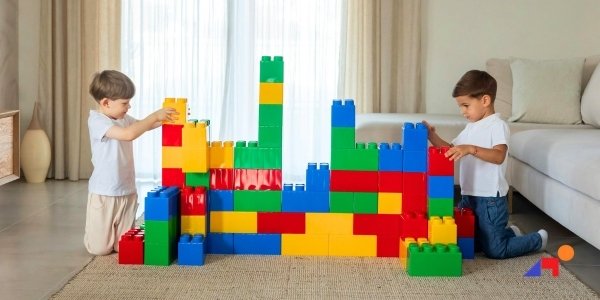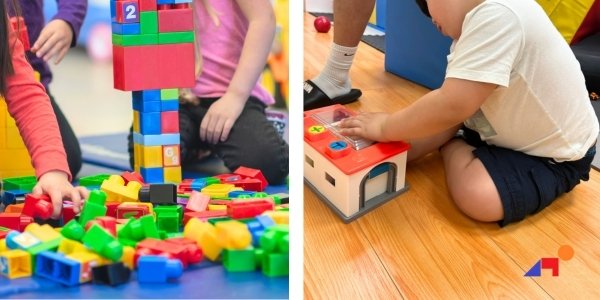Vancouver Pediatric Therapy: Why Fun Equals Learning
Play isn’t just entertainment—it’s the primary way children learn about their world, develop essential skills, and build confidence. When occupational therapists incorporate play into their sessions, they’re tapping into children’s natural learning mechanisms to achieve therapeutic goals more effectively than traditional exercise-based approaches.
Child-led play approaches like DIRFloortime allow therapists to follow each child’s interests and natural curiosity. When a child is fascinated by dinosaurs, their therapist might create obstacle courses that involve “escaping from T-Rex” to work on gross motor skills, or design fine motor activities around “feeding baby dinosaurs” to strengthen hand muscles. This personalized approach ensures children remain engaged while working toward their therapeutic objectives.
Research shows that play-based interventions can improve social and emotional regulation by up to 70% compared to traditional therapy methods. This is particularly significant for Vancouver children dealing with anxiety, attention challenges, or sensory processing differences, who often struggle with conventional therapeutic approaches.
Key benefits of play-based therapy include:
- Enhanced motivation: Children eagerly participate when activities feel like games rather than work
- Natural skill generalization: Skills learned through play transfer more easily to real-world situations
- Reduced therapy anxiety: Fun activities eliminate fear and resistance often associated with medical settings
- Improved self-confidence: Success in play builds overall self-esteem and willingness to try new challenges
- Better family engagement: Parents can easily replicate play activities at home
The beauty of play therapy lies in its ability to address multiple developmental areas simultaneously. A single game of Twister, for example, works on balance, body awareness, motor planning, following directions, and social interaction—all while the child focuses on having fun rather than “doing therapy.”
Creative Play Interventions: From Pirate Ships to Tea Parties
Vancouver occupational therapists are masters at disguising therapy as play, creating themed activities that captivate children’s imaginations while addressing specific developmental needs. These creative interventions prove that the most effective therapy often doesn’t feel like therapy at all.
Obstacle courses and adventure themes transform gross motor challenges into exciting quests. A child working on balance and coordination might navigate a “pirate ship deck” (balance beam) during a storm (while music plays), climb through “caves” (tunnels), and search for treasure (fine motor sorting activities). Each element serves a therapeutic purpose while maintaining the adventure narrative.
Dramatic play and storytelling offer powerful tools for children with communication challenges or social skill development needs. Through puppet shows, dress-up games, and role-playing scenarios, children practice social interactions, emotional expression, and problem-solving in safe, supportive environments. A shy child might find their voice by speaking through a friendly puppet, while a child with autism practices social scripts through structured pretend play.
Sensory play experiences address one of the most common needs among Vancouver pediatric therapy clients. Activities with play dough, kinetic sand, bubbles, and textured materials help children regulate their sensory systems while building tolerance for different textures and experiences. These activities are particularly effective for children with sensory processing differences who may be over- or under-responsive to environmental stimuli.
Examples of themed therapeutic play:
- “Restaurant” play: Taking orders (writing practice), carrying trays (balance/coordination), preparing food (bilateral coordination)
- “Construction site” activities: Building with blocks (spatial skills), using toy tools (bilateral coordination), following blueprints (visual processing)
- “Art studio” sessions: Painting (shoulder stability), sculpting (hand strength), collaging (fine motor precision)
- “Science lab” experiments: Measuring (math concepts), mixing (bilateral skills), observing (attention/focus)
The key to successful themed play is ensuring every activity serves a specific therapeutic purpose while maintaining the child’s engagement through meaningful, enjoyable experiences.
Technology Meets Play: Virtual Reality and Interactive Gaming
Vancouver’s pediatric occupational therapy landscape is embracing cutting-edge technology to create even more engaging and effective play-based interventions. Virtual reality (VR) and interactive gaming platforms are opening new possibilities for therapeutic play that were unimaginable just a few years ago.
VR-based therapeutic play creates immersive environments where children can practice skills in safe, controlled settings. A child afraid of swings might comfortably experience vestibular input through virtual playground equipment, while a child working on bilateral coordination might “paddle a canoe” through virtual rivers. These experiences feel like sophisticated video games while providing precisely controlled therapeutic input.
Interactive gaming systems like motion-controlled games encourage physical movement while providing immediate visual feedback. Children might “conduct a virtual orchestra” to work on shoulder stability and range of motion, or “paint masterpieces” through arm movements to develop gross motor control. The gamification aspect maintains motivation through achievement levels, rewards, and progress tracking.
Social VR environments offer particular promise for children with autism or social anxiety. These platforms allow therapists to create controlled social scenarios where children can practice interactions, recognize social cues, and build confidence in virtual settings that feel safe and manageable.
Benefits of technology-enhanced play therapy:
- Precise control: Therapists can adjust difficulty, sensory input, and environmental factors instantly
- Objective measurement: Technology provides detailed data on movement patterns, reaction times, and progress
- Endless variety: Virtual environments prevent boredom and maintain long-term engagement
- Home connectivity: Some systems allow continued practice between therapy sessions
- Multi-sensory integration: Combined visual, auditory, and tactile feedback enhances learning
While technology enhances play therapy, it never replaces the essential human connection between therapist and child. The most effective approaches blend high-tech tools with traditional play activities, creating comprehensive treatment programs that address each child’s unique needs and interests.
Individualized Play: Matching Activities to Each Child’s Needs

Every Vancouver child who walks into occupational therapy brings their own unique combination of strengths, challenges, interests, and personality traits. Successful play therapy requires careful assessment and customization of activities to match each child’s developmental profile, interests, and therapeutic goals.
Comprehensive assessment forms the foundation of individualized play therapy. Vancouver occupational therapists use standardized assessments alongside careful observation of how children naturally play and interact with their environment. This dual approach reveals not only what skills need development, but also which play activities will most effectively engage each individual child.
For children with sensory processing differences, play activities must be carefully calibrated to provide “just right” sensory input. A child who seeks intense sensory experiences might thrive with heavy work activities like pushing wagons or jumping on trampolines, while a sensory-sensitive child might prefer quieter activities with predictable textures and controlled environments.
Cultural sensitivity plays a crucial role in Vancouver’s diverse community. Therapists adapt play activities to reflect children’s cultural backgrounds and family values, ensuring therapy feels relevant and respectful. This might mean incorporating traditional games from a child’s heritage culture or adapting activities to match family communication styles and expectations.
Individualization strategies include:
- Interest-based planning: Building therapy around dinosaurs, princesses, sports, or whatever captivates each child
- Learning style adaptation: Visual, auditory, or kinesthetic approaches based on individual preferences
- Developmental staging: Adjusting complexity to match current skill level while providing appropriate challenge
- Communication matching: Adapting verbal instructions, visual supports, or demonstration methods
- Energy level consideration: High-movement activities for active children, calmer approaches for those needing regulation
The art of individualization lies in observing how each child responds to different activities and continuously adjusting the therapeutic approach. A child who initially resists fine motor activities might engage enthusiastically when those same skills are embedded in a cooking game or art project that matches their interests.
Family Integration: Teaching Parents to Be Play Partners
The most successful pediatric occupational therapy outcomes occur when families become active partners in their child’s therapeutic journey. Teaching parents and caregivers how to incorporate play-based strategies into daily routines extends therapy benefits far beyond the clinic walls.
Home program design focuses on simple, achievable activities that families can realistically integrate into their busy schedules. Rather than asking parents to become therapists, occupational therapists teach them how to recognize therapeutic opportunities in everyday activities—turning bath time into sensory play, transforming chores into gross motor activities, or making meal preparation into fine motor practice.
Parent coaching sessions help caregivers understand the therapeutic principles behind play activities, enabling them to adapt and modify activities based on their child’s daily needs and interests. This knowledge empowers parents to support their child’s development confidently and consistently.
Sibling involvement creates additional opportunities for therapeutic play while strengthening family relationships. Occupational therapists often design activities that engage the whole family, ensuring therapy doesn’t isolate the child receiving services but instead brings families together through meaningful, fun experiences.
Effective family integration includes:
- Simple activity modifications: Teaching parents how to add therapeutic elements to existing routines
- Environmental adaptations: Helping families create play spaces that support their child’s needs
- Progress celebration: Teaching families to recognize and celebrate small developmental victories
- Problem-solving strategies: Equipping parents with tools to handle challenges that arise during play
- Resource recommendations: Suggesting appropriate toys, games, and activities for continued development
When families understand how to support their child’s development through play, therapy gains momentum that extends throughout the week, not just during scheduled sessions. This comprehensive approach accelerates progress and helps children generalize skills across all environments.
Measuring Success: Progress Through Play
Tracking progress in play-based occupational therapy requires creative assessment methods that capture improvements in engagement, skill development, and functional outcomes. Vancouver therapists use both formal assessment tools and observational data to document how play interventions translate into real-world improvements.
Engagement metrics measure how actively children participate in therapeutic activities, tracking factors like attention span, initiation of activities, and emotional regulation during sessions. These indicators often improve before specific skill gains become apparent, providing early evidence of therapeutic effectiveness.
Functional skill assessment examines how therapy gains transfer to daily activities at home and school. A child working on fine motor skills through play might show improvement in putting on buttons, using utensils, or completing art projects in their classroom. These real-world applications demonstrate the true value of play-based interventions.
Goal attainment scaling allows therapists to measure progress toward individualized objectives while accounting for each child’s unique starting point and developmental trajectory. This approach recognizes that success looks different for every child and celebrates meaningful gains regardless of their magnitude.
Progress measurement tools include:
- Video analysis: Comparing movement quality and skill execution over time
- Parent questionnaires: Tracking functional improvements in home and community settings
- Standardized assessments: Formal testing to document skill development in specific areas
- Self-assessment tools: Age-appropriate methods for children to report their own progress and confidence
- Educational collaboration: Input from teachers and school staff about classroom performance
The most meaningful progress often occurs in areas that standardized tests can’t fully capture—increased confidence, improved peer relationships, greater willingness to try new activities, and enhanced family interactions. These qualitative improvements frequently prove more significant for long-term success than quantitative skill measures alone.
Vancouver Occupational Pediatric Therapy | Kidstart Pediatric
Play therapy techniques have revolutionized pediatric occupational therapy by transforming potentially challenging sessions into engaging, effective learning experiences that children love. When therapy feels like play, children develop essential skills naturally while building confidence and positive associations with their therapeutic journey.
For Vancouver families seeking the most effective pediatric occupational therapy, choosing providers like Kidstart Pediatric Therapy who expertly integrate evidence-based play strategies ensures children receive therapy that’s both enjoyable and remarkably effective.
Frequently Asked Questions (FAQs)
1. What makes play therapy more effective for pediatric therapy in Vancouver?
Play therapy uses natural child interests and fun activities to reduce anxiety and increase motivation, leading to better participation and improved therapy outcomes. Kidstart Pediatric Therapy specializes in integrating play-based methods tailored to each child’s needs.
2. How does technology enhance pediatric therapy experiences?
Technologies like virtual reality and interactive gaming make therapy interactive and measurable, helping children engage more deeply while precisely targeting therapeutic goals.
3. Can parents be trained to support their child’s therapy at home?
Yes, parent coaching at Kidstart Pediatric Therapy empowers families with practical techniques to continue therapy benefits between sessions, enhancing overall progress.
4. Are sensory play activities suitable for all children?
Sensory play can be customized to fit each child’s sensory preferences and needs, helping with sensory regulation in a comfortable and controlled manner.
5. How do occupational therapists individualize play therapy for diverse children in Vancouver?
Therapists assess each child’s strengths, challenges, and cultural background to design personalized therapy plans that resonate with their interests and developmental goals.
People Also Ask
What role does play therapy have in emotional development?
Play therapy supports children in expressing emotions safely and learning emotional regulation, which contributes to improved behavior and confidence.
How can themed play activities improve communication skills?
Themed play uses role-playing and storytelling to foster social interaction and language use in engaging, low-pressure settings.
Why is family involvement important in pediatric therapy?
Active family participation builds trust and continuity, amplifying therapy impacts and encouraging children’s consistent progress.
What are the advantages of VR in pediatric therapy?
VR offers immersive, repeatable environments for practicing skills safely and enhances motivation through interactive gamification.
How is progress measured in play-based pediatric therapy?
Therapists use observational data, parent feedback, and standardized tools to capture gains in skills, engagement, and functional behaviors.






